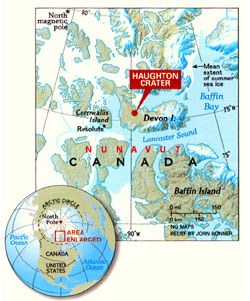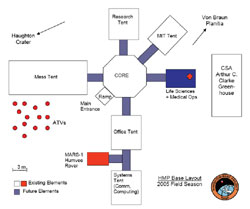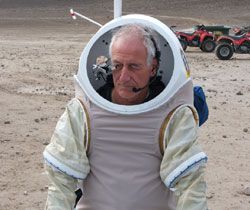| home this issue archives editorial board contact us faculty website |

| Vol.
XVIII No.
1 September / October 2005 |
| contents |
| Printable Version |
Expedition to "Mars on Earth"
There will always be some disagreement about the ideal place to summer. While many note that Cape Cod combines convenience and style, others insist that a more northern location, perhaps the coast of Maine, is preferable. A team of researchers from the MIT Department of Aeronautics and Astronautics and the Engineering Systems Division decided to take this argument further by conducting a field expedition to the remote Haughton Mars Project (HMP) research base, a few hundred miles from the magnetic North Pole.
The expedition was conducted as part of an Interplanetary Supply Chain Management project, funded by NASA and led by MIT Professors Olivier de Weck and David Simchi-Levi. The central goal for the arctic field season, which lasted from July 8 to August 6, 2005, was to investigate the similarities between logistics for remote terrestrial sites and supply chains for future planetary Moon and Mars exploration for modeling purposes. Another objective was to deploy and test technologies such as Radio Frequency Identification (RFID) for remote base operations.
The MIT team conducted this research in cooperation with the Haughton Mars Project (www.marsonearth.org), an international interdisciplinary field research project sponsored by NASA and the Canadian Space Agency (CSA) and managed by the Mars Institute. The site is focused on the scientific study of the 38-million-year-old Haughton impact crater and surrounding terrain on Devon Island.

At 75 degrees North latitude, Devon Island is a high arctic desert and the largest uninhabited island on Earth. The site was chosen both for its geological and scientific interest, and its similarity to Mars terrain. While no climate on Earth is exactly like Mars, the unique combination of rocky polar desert, permafrost, and analogous geological formations, afford comparisons to the possible evolution of Mars – in particular the history of water and of past climates, the effects of impacts on Earth and other planets, and the possibilities and limits for life in remote environments.
Beyond basic science, the remote Haughton Mars site functions as an analogue planetary base, supporting a diverse array of exploration technology and engineering test projects that also benefit from the Mars-analogue terrain, remoteness, and exploration-like activities undertaken by geologists and other scientists. For example, over the past several years, the Canadian Space Agency has supported the Arthur C. Clark Greenhouse project, to design, build, and test a greenhouse and autonomous plant-growth technologies in remote environments. Hamilton-Sundstrand, an aerospace engineering firm headquartered in Connecticut, uses the Haughton site to test advanced space suit designs. Also, this year the Drilling Automation for Mars Exploration (DAME) project, lead by the NASA Ames Research Center, tested autonomous fault diagnosis and artificial intelligence software on a prototype Mars drill. Many other exploration technologies and prototypes have been tested at the Haughton base since 1997.
| Back to top |
The Haughton Mars project has its origins in a 1996 National Research Council grant awarded to Dr. Pascal Lee to investigate the potential for the High Arctic to serve as an analogue for Mars exploration. Having identified Devon Island as an excellent location, NASA formally established the Haughton Mars project in 1999, with Dr. Lee as principal investigator and Dr. Kelly Snook at NASA Ames Research Center as project manager. The project has grown over the years and now supports up to 60 researchers over the six-week field season, with a variety of projects from universities, government, and industry.

The base itself has also grown, and now includes a main mess tent, a communication-systems tent, a large office and laboratory tent for general work, a greenhouse test bed, and an octagonal core module that will eventually unite the buildings into a single base-like structure. There are also roughly 20 all-terrain vehicles (ATVs), a Humvee outfitted for longer traverses, and a small airstrip to support Twin Otter airplane flights in and out of base. This year, an MIT tent was erected for the space logistics project and also in preparation for future MIT involvement at the site. As a whole, the base can currently accommodate about 40 to 50 people at a given time, with researchers sleeping in individual tents near the main structures.

The MIT expedition to the Haughton Mars Site on Devon Island was part of the NASA-funded Human and Robotics Technology (HRT) project on "Interplanetary Supply Chain Management & Logistics Architectures." Originally, the plan was to analyze logistics for Antarctic exploration and offshore oil and gas exploration platforms. However, observing and managing the HMP logistics presented itself in early 2005 as an opportunity to deliver much more tangible and direct benefits to NASA. Not only will the project be able to closely observe and model both the micro- and macro-logistics of the base, it will influence the actual logistics of the site as advances made under the project are infused into base operations.
The team thus went to Devon Island to investigate the applicability of the site as an analogue for planetary base micro and macro-logistics, to obtain lessons learned for Supply Chain Management (SCM) to remote environments, and to begin collecting data for modeling purposes. They also tested new technologies and procedures to enhance the ability of humans and robots to jointly explore remote environments on the Earth, the Moon, and Mars.
The MIT expedition had four main objectives for the summer field season:
First, a complete inventory of the base was compiled for future modeling and to create a "complete picture" of the current state of operations. The inventory was partitioned into a taxonomy developed by the project, and incorporated into an SQL relational database for retrieval using multiple "use cases."
The taxonomy contains 10 major classes of supply according to a high-level functional decomposition of research, habitation, and maintenance-related functions on base. It represents a significant advance over current practice for the international space station (ISS) and Antarctic logistics, where multiple fragmented inventories exist, leading to misunderstandings and expensive or dangerous under- or oversupply situations. As a whole, approximately 2300 items were inventoried at HMP, including items for base operations such as fuel and consumables, and items for specific research projects such as the Mars Greenhouse, C-band satellite communications equipment, and CSA telemedicine kit. In a wider sense, this objective will help establish a benchmark model for how to efficiently operate a multi-national, multi-organization research base in remote environments.
A second major field-season objective was to create and quantify an initial network model of the HMP supply chain. This network model will be used as a benchmark for a comprehensive interplanetary exploration logistics discrete event simulation.
The simulation will have the ability to capture flights of vehicles in and out of base and to capture the associated forward and reverse cargo flows. Combined with powerful bin packing and network optimization algorithms, it will help base managers organize and plan Twin Otter flights (cargo missions) more efficiently than currently possible. Based on the difference between the planned and actual number of required flights (20 vs. 28) in this field season, the team estimated that the transportation optimization potential of HMP may be on the order of 30-40 percent.
Third, the MIT team experimented with RFID technology to ascertain both its potential benefits and limitations in the context of remote base operations. The basic ability to associate an object with information and then to autonomously track the location and state of assets, agents, and vehicles, has the potential to help many aspects of surface operations. Most obviously, it could save researchers precious time by accurately and effortlessly tracking objects as they move about base, and reporting exact levels of supply. It could also enable more exotic applications, such as the rapid "check-out" of vehicles for traverse using hand-held readers. Similarly, "smart shelves" that sense what items are on them could also save researchers time locating and analyzing rock and soil samples obtained during field excursions.
While promising, many questions remain about the basic utility and limits of RFID technology for remote base operations. Testing at HMP therefore had two elements: formal scientific studies, and less formal experimentation with the basic technology as lessons were learned about base operations. Formal studies included an experiment to evaluate the benefits of RFID in terms of accuracy and timesavings compared to other technologies such as bar coding. A system was also developed to precisely monitor the flow of ATV traffic in and out of camp.
Preliminary results of these studies suggest, among other points, that while RFID technology will undoubtedly save time, basic improvements in accuracy and system design will be needed to justify their cost and mass. Most likely, special packaging would be needed to overcome basic problems of radio-wave reflection and attenuation. Further, it became clear that to avoid RF interference an RFID system needs to be designed together with the overall communications architecture of the base, rather than retrofitted as an afterthought.
| Back to top |
These issues notwithstanding, observations of base operations have suggested potentially valuable niche applications for RFID technology beyond those conceived before the expedition. "Smart containers" that can precisely identify their contents while remaining RF opaque would be one helpful application. Further, a centralized information "kiosk" to distribute such information and monitor levels of critical consumables such as fuel and food would also be important. Future work will build on these findings to design and test more comprehensive RFID systems for remote base applications. HMP offers the potential to create a fully integrated, intelligent and multi-disciplinary research environment

The fourth major goal for the MIT expedition was to establish logistics requirements for extra vehicular activities (EVAs) through observations of short ATV traverses and longer excursions with overnight stays. This goal links EVA planning to the micro-logistics modeling efforts. MIT researchers accompanied geologists on excursions into the Haughton crater and other areas on Devon Island, recording planning strategies--re-planning in the case of unexpected events or discoveries--supplies taken along, and caching possibilities (e.g., via air delivery). Further, an MIT-developed re-planning software tool was tested.
In addition to these research objectives, the MIT team prepared for more substantial involvement with the Haughton Mars Project starting in the 2006 field season. This will include human/robotic experiments (Prof. Jeff Hoffman), potential EVA suit work (Prof. Dava Newman), autonomous reconfigurable rovers (Prof. Brian Williams, Prof. David Miller), continued space logistics work (Prof. de Weck, Prof. Simchi-Levi), and the eventual testing of a pressurized lightweight planetary camper vehicle (Prof. de Weck).
This continued engagement, together with the availability of the MIT tent, provides the opportunity for other researchers in the MIT community to participate in the Haughton Mars Project. Given the multidisciplinary nature of work at Haughton, this possibility extends to any researchers with an interest in conducting research in the High Arctic. For example, in addition to the previously mentioned projects, the site has supported basic science in geology, glaciology, and microbiology, testing of scientific instruments and procedures such as weather balloons and monitoring equipment, and the testing of multiple prototype robotic technologies in the rocky desert. The MIT facility is open for participation by researchers in other departments and laboratories, such as Mechanical Engineering or Earth, Atmospheric and Planetary Sciences (please contact Prof. de Weck for details).
As their winter-like summer in the land of the midnight sun comes to an end, the MIT team has now returned to sort, analyze, and better understand the data collected and lessons learned from the HMP expedition. As advances are made toward their ultimate goal of efficiently and reliably supplying exploration bases on the Moon and Mars, we may one day be able to summer in even more unorthodox locations than Devon Island.
| Back to top | |
| Send your comments |
| home this issue archives editorial board contact us faculty website |